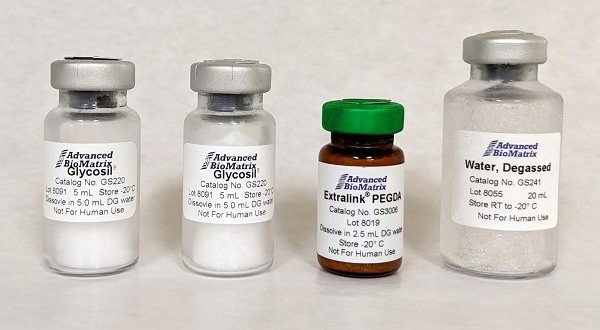Overview
Xeno-free and totally adaptable HyStem® hydrogels are available. Recommended for cellular applications that call for the optimization of a specific attachment factor as well as non-adherent cell culture.
The HyStem Hydrogel Kits are ideal for growing stem cells in their hyaluronic acid-rich (HA) environment. Extracellular matrix (ECM) proteins or cell attachment peptides can be incorporated into HyStem hydrogels to provide attachment sites and/or differentiation signals.
By adjusting the hydrogel’s rigidity to correspond to the native cell environment, they can also be altered. Any format, including T-flasks, tissue culture inserts, and 384-well microplates, can successfully cultivate cells using the HyStem hydrogel system.
Product may be shipped at room temperature, but please store it at –20 °C until needed.

Image Credit: Advanced BioMatrix
Features
- Dimensionality (3-D encapsulation or 2-D plating on top of hydrogel)
- Flexible culture format (384- through 6-well plates, tissue-culture inserts, and T-flasks)
- Variable amounts and types of ECM protein incorporated
- Gelation properties including gelation time and hydrogel stiffness
Applications
Animal-free system
- Since their two constituents are a thiol-modified hyaluronan (Glycosil®) and a thiol-reactive crosslinker (polyethylene glycol diacrylate, Extralink®-Lite), HyStem hydrogels are xeno-free
- Bacillus subtilis (Novozymes) is used in a specialized bacterial-fermentation process to create the hyaluronic acid used to make HyStem. There are absolutely no ingredients or raw materials used in its production that come from animals
- A polyethylene glycol (PEG) polymer is converted into Extralink (polyethylene glycol diacrylate) by attaching acrylate groups to both ends of the polymer
- PEG is made without using any materials from animals and is derived from petroleum and inorganic sources
Gelation
- HyStem-C components that have been reconstituted withstand several hours of liquidity at 15–37 °C. By mixing Glycosil® (thiol-modified hyaluronan) with Extralink®-Lite (PEGDA), a crosslinking agent, the hydrogel is created
- After the three components are combined, gelation happens in about twenty minutes. Low temperatures or a low pH have no bearing on any steps
- The gelation time could be extended by diluting the ingredients with a cell culture medium or phosphate-buffered saline (PBS)
3D cell recovery matrix
- The alternative crosslinker PEGSSDA is available for use with all HyStem hydrogel kits for applications where cell recovery is crucial. In addition to offering the same benefits as Extralink, this crosslinker also has the advantage of having easily reducible internal bonds
- Instead of using slow enzymatic techniques that may affect cell viability, this enables quick, simple recovery of single cells or clusters from the hydrogel for applications like RNA analysis or flow cytometry
- Researchers are encouraged to get in touch with us to find out whether specific cell types or culture systems are compatible with PEGSSDA